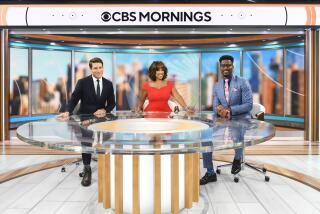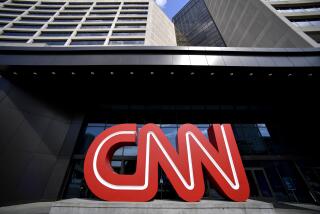‘CNN Newsroom,’ ‘Channel One’ Strive to Make the Grade
- Share via
Television news in the classroom?
It’s a fine idea if made relevant and executed with care and vision.
Cable News Network appears to have done just that with “CNN Newsroom,” its weekday newscast for schoolkids that premiered in this morning’s wee hours, available for window-shopping by teachers who may want to regularly tape it and show it to their students when school resumes next month.
Based on a preview tape, the decidedly unflashy “CNN Newsroom” is vastly worthier than “Channel One,” the controversial Whittle Communications newscast that played like an extended music video when introduced in a five-week trial in selected schools last spring. Tennesee-based Whittle says the same format will apply for a full-blown national launching scheduled for March.
In September, CNN hopes to have its newscast in 1,000 schools, the same number targeted by Whittle for next year.
Meanwhile, cable’s TV-in-the-classroom landscape will expand even further with the Aug. 21 start of “Short Subjects,” 10-minute C-SPAN vignettes on the government and topical issues, airing at 10 p.m. Mondays and designed for use by high schools and colleges. And coming Sept. 18 is the Discovery Channel’s “Assignment: Discovery,” weekday curriculum supplements of 20-25 minutes in science, social studies and so on.
The C-SPAN and Discovery offerings bear monitoring. However, the battle to watch is between the 15-minute, commercial-free “CNN Newsroom,” which must be taped off the air by schools or teachers at 12:45 a.m., and the 12-minute, commercial-fraught “Channel One,” which will be beamed by satellite directly into classrooms.
Under Whittle’s original plan, schools would receive $50,000 in electronic gear only if they agreed to show “Channel One” to all their students, thereby exposing an entire student body to the commercials. However, that requirement has since been dropped by Whittle.
Far more than “Channel One,” “CNN Newsroom” appears to be an excellent opportunity to make education more meaningful by turning on junior and senior high school kids to current affairs related to their school work. With this newscast, CNN has an opportunity to provide a sterling public service and, as a bonus, invest in its own future by accustoming young viewers to watch CNN.
Although the program is offered free, CNN says there is a charge of as much as $1 a day for a daily curriculum guide for teachers that will be furnished schools electronically upon request.
CNN has added “CNN Newsroom” to the duties of Jay Suber, executive producer of the network’s “This Week in Review.” Fronted by fresh young co-anchors Brian Todd and Cassandra Henderson, the new program seems understaffed with only two reporters of its own. Their stories will air with pieces from CNN’s regular newscasts.
The 13 stories on the preview tape (which, CNN emphasized, was no more than a “rehearsal”) ranged from brief headlines to three minutes on the impact of AIDS on teen-agers. Three other stories ran two to three minutes--pretty hefty for TV.
“CNN Newsroom” is at once professional and, unlike “Channel One,” appealingly unglossy and free of celebrity narrators, thumping music, blinding graphics and blazing neon brightness. And, of course, there are no commercials.
The inclusion of four 30-second commercials per newscast is what has made “Channel One” controversial and led to its condemnation by Bill Honig, superintendent of public instruction in California, where Gahr High School in Cerritos was one of six schools nationwide that participated in the “Channel One” pilot project.
Echoing others objecting to commercials beamed into classrooms, Honig dismissed “Channel One” as “forced commercialization in school” and vowed that any California schools airing “Channel One” in the future would be docked state funding in accordance with the time students spent viewing the newscast.
Right decision, wrong reason.
The commercials aren’t what’s wrong with “Channel One.” On the contrary, they’re valuable. They should be studied in class, with students encouraged to dissect and analyze them to better understand the sophisticated selling techniques they employ.
What’s wrong with “Channel One” is not commercials, only that it resembles the commercials.
The most depressing element of the “Channel One” controversy is that so many teachers publicly have expressed their support of the newscast. They’ve been watching too much TV.
Apparently what we are seeing is the impact of one TV generation educating another, one set of fried minds imposing their own TV-distorted perceptions on a younger set of minds, teachers feeling it is fine for their students to watch news that you can dance to.
The differences between “CNN Newsroom” and “Channel One” amount to more than just a few jeans and candy commercials. The differences amount to an entire philosophy of journalism.
The commercials are longer than most of the stories on “Channel One,” which teaches students that news is indigestible unless accompanied by such TVisms as “exclusive” and a fast track of grinding music, horns, flashes and catchy titles from “Flash Back” to “Fast Fact” to “Pop Quiz.”
Anchor Lynn Blades: “OK, pop quiz: What major feature did Henry Ford leave out of his first automobile?”
The answer: reverse gear.
OK, pop quiz: What major feature did Whittle leave out of “Channel One”?
The answer: intelligence.
“CNN Newsroom” promises a better future.
More to Read
The biggest entertainment stories
Get our big stories about Hollywood, film, television, music, arts, culture and more right in your inbox as soon as they publish.
You may occasionally receive promotional content from the Los Angeles Times.










